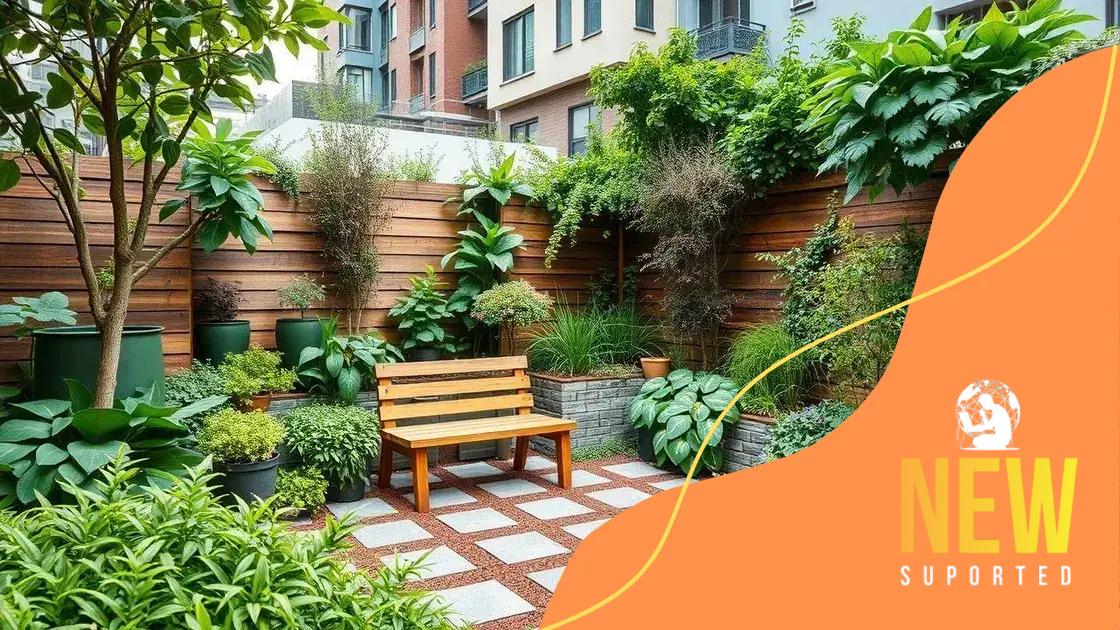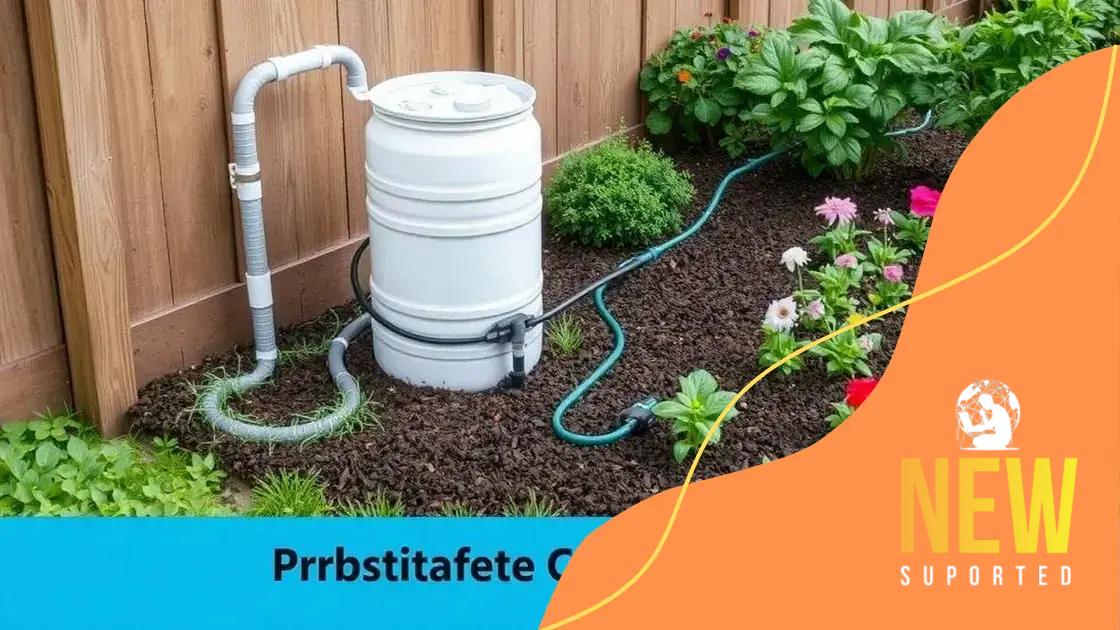How to create an eco-friendly garden in urban spaces

Creating an eco-friendly garden in urban spaces involves choosing native plants, using sustainable water methods, composting, and incorporating habitats for local wildlife to promote biodiversity and environmental health.
How to create an eco-friendly garden in urban spaces is a question many city dwellers ask. Imagine stepping out onto your balcony or rooftop and being met by a small green oasis. In this article, discover how simple steps can lead to a thriving, sustainable garden right in the heart of the city.
Understanding urban gardening
Urban gardening is becoming a popular solution for city dwellers. It allows people to connect with nature right where they live. With a little creativity, you can turn even the smallest spaces into productive gardens.
Benefits of Urban Gardening
There are numerous advantages to gardening in urban areas. Not only does it beautify your environment, but it also promotes sustainability.
- Improves air quality: Plants help filter pollutants and supply fresh oxygen.
- Reduces heat: Green spaces can lower temperatures in cities.
- Encourages biodiversity: Urban gardens can be homes for various wildlife.
Engaging in urban gardening also fosters community connections. Neighbors can share tips, seeds, and even harvests. Moreover, it offers a chance to grow your food, which can be both rewarding and economical.
Types of Urban Gardening
There are several methods to consider when starting an urban garden. These techniques can fit into various lifestyles and available spaces.
- Container gardening: This is ideal for small balconies or patios.
- Vertical gardening: Perfect for maximizing space with wall-mounted planters.
- Rooftop gardens: A unique way to utilize often overlooked rooftops.
In addition to these methods, consider using community gardens. These shared spaces allow multiple people to grow food and share resources. They provide a sense of belonging and a common goal among participants.
Planning Your Urban Garden
Planning is essential for a successful garden. Assess your space, sunlight, and climate conditions. Determine which plants will thrive in your environment.
Creating a garden design can include factors like layout, plant types, and accessibility. Make sure to choose plants that suit your gardening style, whether it’s flowers, herbs, or vegetables.
Overall, understanding urban gardening opens up exciting possibilities for green living in cities. It empowers individuals to take action regarding their environment and well-being.
Choosing the right plants for your space
Choosing the right plants for your space is crucial for creating a thriving eco-friendly garden. Each plant has unique needs and characteristics that can influence your gardening success. Understanding these factors is the first step to ensuring your plants flourish.
Consider Your Space
Before selecting plants, assess the area where you intend to garden. Look at aspects like light exposure, available space, and climate. Knowing whether your space is sunny or shaded can guide your choices.
- Sunlight: Identify how many hours of direct sunlight your garden receives.
- Space Size: Determine if you have room for larger plants or if smaller, compact varieties are necessary.
- Climate Zone: Understanding your local climate can help you select plants that thrive in those conditions.
For instance, if your balcony receives full sun, you might consider sun-loving plants like tomatoes or peppers. Meanwhile, a shadowy corner could be perfect for ferns or hostas.
Choosing Native Plants
Native plants are often the best option for your garden. These species are well adapted to local conditions and require less maintenance. They support the local ecosystem by providing food and habitats for wildlife.
- Low Maintenance: Native plants typically need less water and care compared to exotic varieties.
- Supports Local Wildlife: Attract pollinators like bees and butterflies.
- Resilience: Better survival rates in local soil and climate conditions.
Additionally, consider incorporating edible plants into your garden. Items like herbs, strawberries, or leafy greens can be both functional and beautiful. They offer the reward of homegrown produce while enhancing your garden’s aesthetic.
Experiment with Colors and Textures
Combining different colors and textures can make your garden visually appealing. Mixing plants of varying heights and foliage types creates a dynamic space. Think about how the foliage will look throughout each season.
For example, pairing bright flowering plants with lush, green leaves can create a stunning contrast. Use plants that bloom at different times to ensure year-round interest. A well-planned plant selection can turn your garden into a vibrant oasis amidst the urban landscape.
Sustainable water usage methods

Sustainable water usage methods are essential for maintaining an eco-friendly garden in urban areas. Water scarcity is a growing concern, and using water wisely can help your garden thrive while conserving this precious resource.
Collecting Rainwater
One effective way to ensure sustainable watering is to collect rainwater. By installing rain barrels, you can capture runoff from your roof. This harvested water is excellent for watering plants.
- Installation: Place barrels under downspouts to catch water efficiently.
- Savings: Reduces your water bill and is free of chemicals commonly found in tap water.
- Usage: Use collected water for outdoor plants, gardens, and flowers.
Using rainwater not only helps your plants but also reduces the strain on municipal water systems.
Drip Irrigation Systems
Implementing a drip irrigation system can provide water directly to the roots of your plants. This method ensures that water goes where it’s needed most, minimizing waste.
- Efficiency: Delivers water slowly and directly to plant roots, reducing evaporation.
- Customization: Systems can be adjusted to suit the specific needs of different plants.
- Reduce Weeds: Less water on the surrounding soil helps to limit weed growth.
With this approach, you can keep your garden healthy while using less water than traditional watering methods.
Soil Moisture Management
Another critical factor is managing soil moisture. Healthy soil retains moisture better, which means you won’t have to water as often. Adding organic matter, such as compost, improves the soil’s ability to hold water.
Consider using mulch around plants to help reduce evaporation and keep the soil cool. This layer acts as a barrier against sun exposure, ensuring that the soil remains moist for longer periods. Regularly checking soil moisture levels can also help you determine when to water, preventing overwatering.
By adopting these sustainable water usage methods, you make a significant impact on the health of your garden and the planet. Each small change contributes to a larger goal of sustainability in urban gardening.
Creating a compost system
Creating a compost system is a fantastic way to recycle organic waste while enriching your eco-friendly garden. Composting helps reduce landfill waste and provides nutrient-rich soil for your plants.
Understanding Composting
Composting is the process of breaking down organic matter, such as food scraps and yard waste, into a dark, crumbly substance known as compost. This natural fertilizer is essential for improving soil health and fostering plant growth.
- Types of Waste: Fruits, vegetables, coffee grounds, and yard clippings are great additions.
- Avoid: Meat, dairy, and oily foods can attract pests.
- Balance: Aim for a mix of ‘greens’ (nitrogen-rich materials) and ‘browns’ (carbon-rich materials).
Maintaining the right balance ensures your compost decomposes properly and reduces odors.
Setting Up Your Compost Bin
Next, you can create your compost system. Several options are available, from simple heaps to more structured bins. Choose a method that fits your space and lifestyle.
- Heap Method: Simply pile materials in a corner of your garden.
- Bins: Use wooden pallets or buy a compost bin from a store to keep everything contained.
- Tumbling Composters: These are more efficient for quick composting but may require more investment.
Make sure your compost bin has proper ventilation and drainage to support healthy decomposition. Turn the compost regularly to aerate it and speed up the process.
Using Your Compost
Once your compost is ready, usually in a few months, it will smell earthy and have a dark color. You can then use it to enrich your garden soil. Mix compost into garden beds or use it as a top dressing for potted plants.
Compost not only improves soil structure but also adds vital nutrients that help your plants thrive. Regularly incorporating compost into your garden maintenance ensures a rich environment for growth, supporting a sustainable gardening practice.
Incorporating local wildlife habitats
Incorporating local wildlife habitats into your eco-friendly garden can enrich the ecosystem and promote biodiversity. By creating spaces for animals, you contribute to a healthier environment and help local ecosystems thrive.
Understanding Local Wildlife Needs
Different wildlife species have varying requirements for habitats. Some animals need specific foods, while others seek shelter or nesting sites. Knowing these needs is crucial to effectively supporting local wildlife.
- Birds: They require food sources, nesting sites, and safe perches.
- Insects: Pollinators like bees and butterflies thrive in gardens with diverse flowers.
- Small Mammals: Provide cover and food through native plants and ground cover.
Creating environments that cater to these needs helps wildlife not only survive but also flourish.
Planting Native Species
Using native plants in your garden is one of the best ways to support local wildlife. Native plants provide food and shelter tailored to the species in your area. They are also better adapted to local soils and climates, requiring less water and maintenance.
Consider planting flowering plants for pollinators and fruit-bearing plants for birds. Examples of beneficial plants may include coneflower for bees or serviceberry for birds. By naturalizing your garden with local flora, you create a welcoming habitat for wildlife.
Creating Shelter and Nesting Sites
In addition to planting native species, it’s important to create physical spaces where wildlife can thrive. This can include shrubs for shelter, log piles for insects, and birdhouses for nesting.
Leave some areas in your garden undisturbed, as many animals seek refuge in dense plantings or brush piles. These spaces offer protection from predators and harsh weather. Additionally, consider installing bird baths or feeders to attract and provide for birds.
Maintaining a diverse habitat encourages natural interactions between various species. It creates a vibrant and lively garden that supports an array of local wildlife. Your efforts not only beautify your space but contribute positively to the larger ecosystem.
FAQ – Frequently Asked Questions about Creating an Eco-Friendly Garden
What are the benefits of urban gardening?
Urban gardening allows you to connect with nature, improves air quality, and contributes to a sustainable environment by utilizing small spaces effectively.
How do I choose the right plants for my garden?
Consider your space and local climate, and opt for native plants that are well-suited to your environment for easier maintenance and better growth.
What are some sustainable water usage methods?
Collecting rainwater and using drip irrigation systems are great ways to conserve water while keeping your garden healthy.
How can I attract local wildlife to my garden?
Plant native species, provide food sources like bird feeders, and create shelter areas to help support and attract local wildlife.






